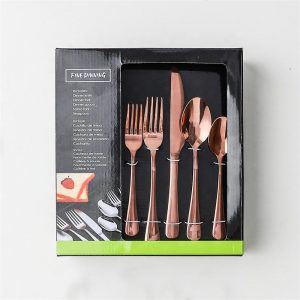The evolution of flatware, also known as cutlery or silverware, has a rich history that spans cultures, materials, and design. Here’s an overview of its development over time:
- Early Utensils: Before the development of distinct flatware sets, early humans used simple tools made from materials like wood, bone, and stone to aid in eating. These utensils were basic and primarily functional.
- Ancient Civilizations: As societies advanced, so did the craftsmanship of utensils. Ancient civilizations like the Egyptians, Greeks, and Romans began using more refined utensils made from metals such as bronze, silver, and gold. These utensils often had intricate designs and were used by the wealthy elite.
- Medieval Europe: During the Middle Ages, utensils were still a symbol of social status. Knives were the most common utensils, often carried by individuals for both eating and protection. Forks were not widely used in Europe until much later.
- Renaissance and Beyond: The Renaissance period brought a resurgence of interest in the arts, including tableware design. This era saw the emergence of more decorative utensils, including ornate silverware and knives with intricately carved handles.
- 17th and 18th Centuries: The use of forks became more widespread during this period. Forks had previously been considered somewhat controversial and even sinful in some cultures. As dining etiquette evolved, specialized utensils like dessert forks and seafood forks were introduced.
- 19th Century: The Industrial Revolution brought significant changes to the production of flatware. Mass production methods made utensils more accessible to a broader range of people. Stainless steel was also invented in the 19th century, revolutionizing flatware production due to its durability and resistance to corrosion.
- 20th Century: The 20th century saw a wide range of design styles in flatware, from the sleek lines of Art Deco to the organic shapes of the Mid-Century Modern era. The introduction of electroplating techniques allowed for the creation of silver-plated flatware that was more affordable than solid silver.
- Contemporary Times: Today, flatware comes in an array of styles, materials, and designs to suit different tastes and occasions. Stainless steel remains the most common material due to its practicality and durability. Modern designs range from minimalist and functional to elaborate and artistic.
- Sustainability and Innovation: In recent years, there has been a growing interest in sustainable materials and eco-friendly production methods for flatware. Alternative materials like bamboo, recycled metal, and biodegradable plastics are being explored.
- Customization and Personalization: With advances in technology, custom and personalized flatware have become more accessible. Individuals can now have their flatware engraved or customized to reflect their unique style and preferences.
The evolution of flatware reflects not only changes in dining habits and materials but also shifts in cultural norms and societal values. From simple tools to intricate pieces of art, flatware has played a significant role in the history of dining and table settings.
















